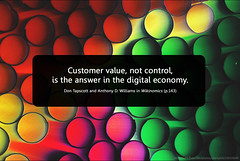 Image by Will Lion via Flickr
Image by Will Lion via Flickr
In my recent article, Buyerology: The New Science of Understanding Buyer Behavior, I introduced the concept of Buyerology and the need for a renewed focus on understanding buyer behavior in the Social Age. A key component of understanding buyer behaviors and decisions is gaining a reality check on Buyer Perceived Values (BPV). How well organizations; in relations to products, service, and brand; maps to Buyer Perceived Values will serve as the one of the primary influences that shapes buyer behaviors and purchase decisions.
Buyer behavior research, performed through qualitative means, can reveal many aspects of what comprises Buyer Perceived Values (BPV). Buyer experience is now becoming one of the most important factors that contributes to and influences these values. The convergence of the Internet and the Social Age, in fact, is introducing many new variables and factors that influence Buyer Perceived Values. Some of the new variables include:
Buyer Experience: previous as well as in process buyer experience can have an enormous impact on how buyers perceive the value that organizations can bring to their challenges and environments. This correlation is becoming stronger as more self-directed experiences by buyers evolve.
Engagement: I have written recently about social engagement as well as how buyers are internalizing their own Social Engagement Index. Evidence is building that how involved and how engaged buyers are is shaping the buyer’s perceived value of making a decision to enter into a relationship as well as make a purchase decision.
Knowledge: shared knowledge related to informative problem solving can help influence positively buyer’s perceived values. This is an area of improvement for the evolving areas of content strategy and content marketing. Just as social media fatigue may be setting in, I am beginning to see signs of content fatigue also. Content creation for the sake of content, especially with dramatic self-promoting marketing flair, is now getting filtered by buyers. The old adage that too much of good thing can actually hurt you can be true in this case.
Network: a new evolving factor is the growing influence of social networks that extends well beyond peer influence. A new dynamic that associates peer recommendations with something we can refer to as network buzz. It is proving to be a tricky formula. A formula that needs to be organic as opposed to imposed upon.
These are just four new and evolving, of sure to be more variables, that influence Buyer Perceived Values. Dramatically calling for the need for further buyer behavior research that can help organizations today understand why and how buyers are making decisions today. This does not minimize nor excludes other conventional type variables such as:
Brand: a strong brand is also a strong leverage point in influencing Buyer Perceived Values (BPV)
Loyalty: the cumulative value of previous buyer experiences and relationships can translate into strong customer loyalty
Quality: no amount of new efforts in social business and content marketing can make up for poor quality and service. Another old adage applies here: make sure your house is in order before you move on.
Risks: let’s face it – changing products or services in a B2B market can turn into an agonizing experience for buyers. Buyers have to see the risks of changing mitigated in order to make a switch. The degree of risks involved has a direct influence on Buyer Perceived Value.
Price: competitive pricing will always remain a significant variable in determining a Buyer’s Perceived Value. The positive or negative impact of other variables can influence the tolerance level on pricing and how it directly influences a Buyer’s Perceived Value.
What we do know is that the above mentioned variables or factors, both new and conventional, translate into Buyer Perceived Values which directly affect the buyer’s behavior and decision-making. How buyers experience these variables or factors throughout the buying process not only will shape their internalized Buyer Perceived Values but also determine how long they choose to stay in the buying process specifically with one organization versus another.
Understanding Buyer Perceived Values requires qualitative research means and constant monitoring as we now live in a hyper-connected and social world. Not only will values shift over time, but we are bound to witness new factors or variables that evolve and further change the buyer landscape.
One place senior executives can start thinking about Buyer Perceived Value (BPV) in general is by asking: do I have any idea what our buyer’s perceived values are?



![[Research Round-Up] New Study Shows the Continuing Value of B2B Thought Leadership](https://customerthink.com/wp-content/uploads/development-2010010_1280-pixabay-innovation-ideas-think-1-218x150.jpg)